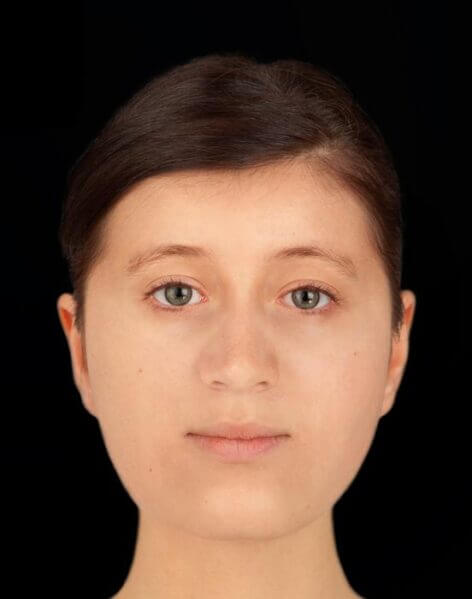Reconstructed Image Reveals 7th-Century Woman Buried with Rare ‘Trumpington Cross
The face of a 16-year-old woman buried near Cambridge, UK, in the 7th century, along with a rare gold and garnet cross known as the ‘Trumpington Cross,’ has been reconstructed through the analysis of her skull. This captivating image will be publicly unveiled for the first time on June 21st, accompanied by new scientific evidence revealing that she migrated to England from Central Europe as a young girl, resulting in intriguing dietary changes.
The Museum of Archaeology and Anthropology (MAA) in Cambridge will showcase the reconstructed image and artifacts from the enigmatic woman’s burial, which was discovered in 2012 by the Cambridge Archaeological Unit at Trumpington Meadows. The exhibition, titled ‘Beneath Our Feet: Archaeology of the Cambridge Region,’ will run from June 21st to April 14th, 2024.
Forensic artist Hew Morrison employed the woman’s skull measurements and tissue depth data for Caucasian females to create the likeness. Although the precise eye and hair color cannot be determined without DNA analysis, the image provides a strong representation of her appearance shortly before her death.
“It was interesting to see her face take shape. Her left eye was slightly lower, about half a centimeter, than her right eye. This would have been quite noticeable in life,” shared Hew Morrison.
Bioarchaeologists Dr. Sam Leggett and Dr. Alice Rose, along with archaeologist Dr. Emma Brownlee, conducted isotopic analysis of the young woman’s bones and teeth during their PhD research at the University of Cambridge. The analysis revealed that she migrated to England from a location near the Alps, potentially southern Germany, after reaching the age of seven.
Leggett and Rose also discovered that once the girl arrived in England, there was a slight but significant decrease in the proportion of protein in her diet. This change occurred towards the end of her young life, indicating a tragically short period between her migration and burial near Cambridge.
“She was quite a young girl when she moved, likely from part of southern Germany, close to the Alps, to a very flat part of England. She was probably quite unwell and she traveled a long way to somewhere completely unfamiliar – even the food was different. It must have been scary,” reflected Dr. Leggett, who is now based at the University of Edinburgh.
Previous analysis had indicated that the young woman had experienced illness, yet the cause of her death remains unknown. She was buried in a remarkable manner, lying on a carved wooden bed adorned with the cross, gold pins (also exhibited), and fine clothing.
Her burial is one of only 18 bed burials ever found in the UK. The ornate ‘Trumpington Cross,’ crafted from gold and garnets in the third quarter of the 7th century, is one of only five of its kind discovered in Britain. It signifies her status as one of England’s earliest converts to Christianity, potentially belonging to the aristocracy or even royalty. A well-known example of a similar cross was found in St. Cuthbert’s coffin.
In 597 AD, Pope Gregory I sent St. Augustine to England with the mission to convert the pagan Anglo-Saxon kings, a process that continued for several decades.
“She must have been aware of her importance and had to bear that responsibility. Her isotopic results align with two other women who were buried on beds during the same period in Cambridgeshire. It appears that she was part of an elite group of women who likely traveled from mainland Europe, most likely Germany, in the 7th century. However, they still remain somewhat mysterious. Were they political brides or perhaps devoted to Christ? The fact that her diet changed upon her arrival in England suggests that her lifestyle may have undergone significant transformations,” proposed Dr. Leggett.
Dr. Sam Lucy
, a specialist in Anglo-Saxon burial from Newnham College, Cambridge, who published the Anglo-Saxon excavations at Trumpington, expressed enthusiasm about the intriguing findings and how they contribute to a better understanding of that period. The combination of the new isotopic results with Emma Brownlee’s research on European bed burials suggests the movement of a small group of young elite women from a mountainous area in continental Europe to the Cambridge region during the third quarter of the seventh century.
“Southern Germany is a likely possibility due to the known bed burial tradition in that area. Given the increasingly certain association between bed burials, such cross-shaped jewelry, and early Anglo-Saxon Christianity, it is possible that their movement was connected to pan-European networks of elite women who played a significant role in the early Church,” added Dr. Lucy.
Dr. Jody Joy, co-curator of the exhibition, highlighted the significance of the young woman’s story and its relevance to understanding pivotal moments in Cambridgeshire’s history. MAA possesses one of Britain’s most important collections of Early Medieval archaeology, and the Trumpington bed burial holds a crucial place within it. Dr. Joy believes that the burial still has much more to teach us.
The exhibition will present the ‘Trumpington Cross’ alongside delicate gold and garnet pins connected by a gold chain, which were discovered near the young woman’s neck. These pins likely secured a long veil to an outer garment made of fine linen, creating a captivating visual effect as she moved. The decorative headboard of the burial bed will also be exhibited.


